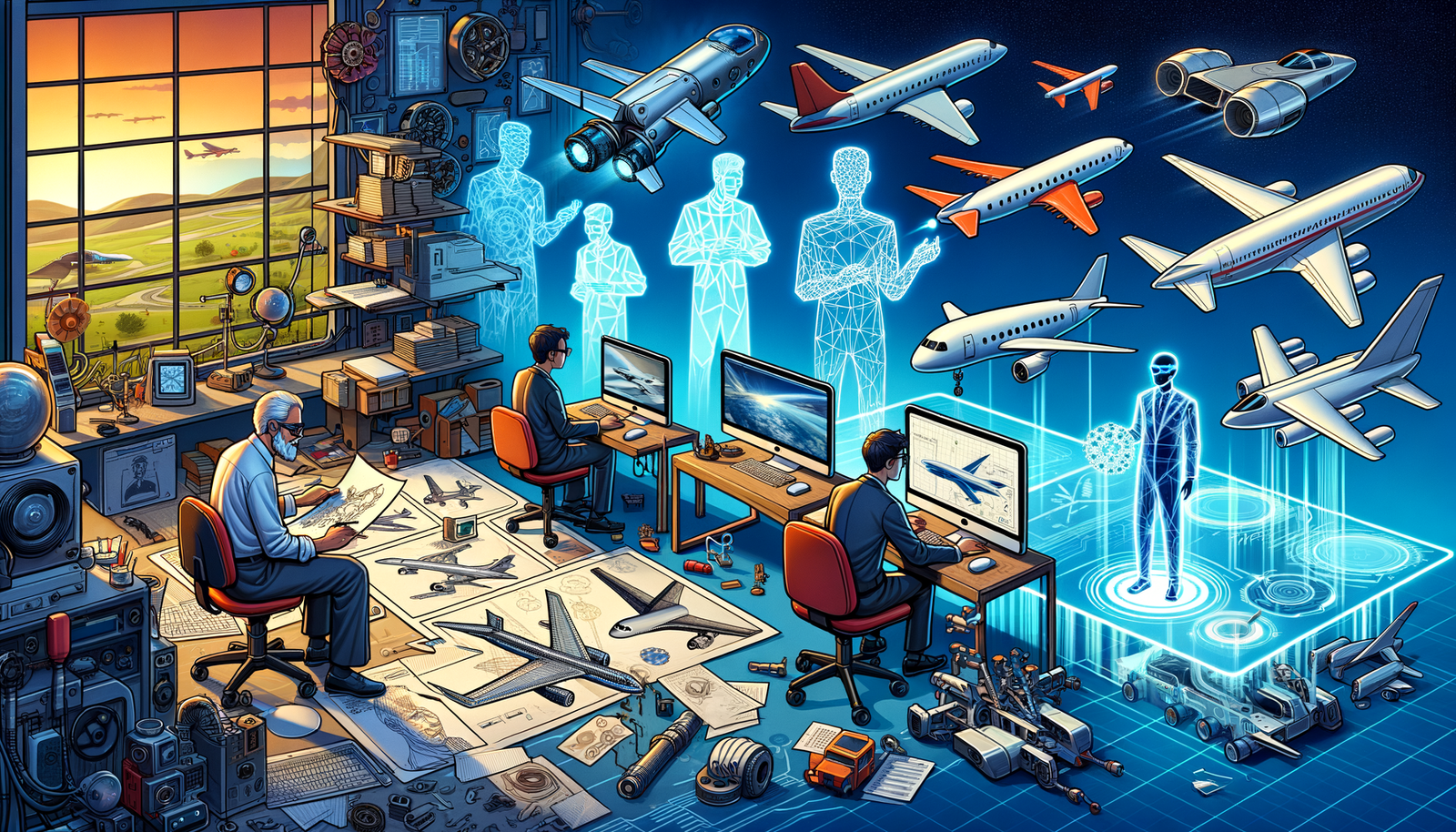Your Cart is Empty
Customer Testimonials
-
"Great customer service. The folks at Novedge were super helpful in navigating a somewhat complicated order including software upgrades and serial numbers in various stages of inactivity. They were friendly and helpful throughout the process.."
Ruben Ruckmark
"Quick & very helpful. We have been using Novedge for years and are very happy with their quick service when we need to make a purchase and excellent support resolving any issues."
Will Woodson
"Scott is the best. He reminds me about subscriptions dates, guides me in the correct direction for updates. He always responds promptly to me. He is literally the reason I continue to work with Novedge and will do so in the future."
Edward Mchugh
"Calvin Lok is “the man”. After my purchase of Sketchup 2021, he called me and provided step-by-step instructions to ease me through difficulties I was having with the setup of my new software."
Mike Borzage
Design Software History: Digital Manufacturing in Aerospace: From Manual Drafting to AI and Quantum Computing
June 22, 2024 5 min read


The Roots of Digital Manufacturing in Aerospace
Early Beginnings: From Manual to CAD
The aerospace industry has long been at the forefront of technological innovation. Before the advent of digital technologies, aerospace manufacturing was a meticulous, labor-intensive process. Engineers relied on manual drafting tools, slide rules, and physical prototypes to design and test new aircraft and spacecraft. This period saw significant advancements, but it was constrained by the limitations of manual methods.
The introduction of Computer-Aided Design (CAD) in the aerospace industry marked a pivotal shift. CAD technologies enabled engineers to create precise, detailed models on computers, dramatically improving the design process. Among the early adopters were key industry players such as Boeing, Lockheed Martin, and Dassault Systèmes. These companies recognized the potential of CAD to enhance accuracy, reduce design cycles, and facilitate more complex geometries.
The Digital Transformation: Integrating CAD/CAM
The transition from 2D to 3D modeling was a significant milestone in the evolution of aerospace design. Early CAD systems primarily supported 2D drafting, but as technology advanced, 3D modeling became the standard. This shift allowed for more comprehensive visualization and analysis of designs, enabling engineers to identify and address potential issues earlier in the development process.
Computer-Aided Manufacturing (CAM) soon followed, further revolutionizing aerospace manufacturing. CAM software integrated with CAD systems to automate the generation of tool paths for machining and fabrication. This integration reduced lead times and improved manufacturing precision. Software like CATIA and AutoCAD played crucial roles in early aerospace projects, providing robust platforms for both design and manufacturing.
The Rise of Digital Manufacturing Technologies
The Advent of Additive Manufacturing in Aerospace
Additive Manufacturing (AM), commonly known as 3D printing, has emerged as a transformative technology in aerospace. AM technologies build parts layer by layer from digital models, allowing for unprecedented design freedom and customization. Aerospace companies were among the early adopters of 3D printing, recognizing its potential to create complex, lightweight components that traditional manufacturing methods could not achieve.
AM offers several significant benefits for aerospace applications:
- Weight reduction: AM enables the creation of optimized, lightweight structures that maintain strength and performance.
- Complex geometries: Engineers can design intricate parts with internal features that would be impossible to manufacture using conventional methods.
- Reduced lead times: 3D printing accelerates the prototyping and production processes, allowing for faster iterations and shorter development cycles.
Key Players and Innovations
Several companies have been driving the adoption of AM in aerospace, including Airbus, GE Aviation, and NASA. These organizations have been at the forefront of numerous groundbreaking projects and milestones, such as 3D printed engine parts and satellite components.
Software tools for design and simulation have played a critical role in the success of these projects. Platforms like Siemens NX and ANSYS provide advanced capabilities for modeling, analyzing, and optimizing AM processes, ensuring that parts meet stringent performance and safety standards.
Challenges and Solutions in Digital Manufacturing
Material and Process Challenges
Despite its many advantages, digital manufacturing, particularly AM, faces several challenges. One of the primary issues is ensuring that materials used in 3D printing meet the necessary performance and certification requirements for aerospace applications. Traditional materials often behave differently when printed, necessitating extensive research and testing to develop new alloys and composites suitable for AM.
Overcoming limitations in AM technologies is another critical area of focus. Early 3D printers were limited in terms of the materials they could process and the size of parts they could produce. Continuous innovation in material science and printing technologies has been crucial in addressing these challenges. New alloys and composites have been developed specifically for 3D printing, providing enhanced properties and performance.
Integration and Standardization
Integrating AM with existing manufacturing processes presents another set of challenges. Ensuring consistency and quality across different manufacturing methods requires sophisticated software solutions. CAD and CAM platforms must seamlessly integrate with AM technologies to provide a cohesive workflow from design to production.
Efforts towards standardization are essential to the widespread adoption of AM in aerospace. Industry standards and guidelines are being developed to ensure that parts produced using AM meet rigorous safety and performance criteria. These standards help build trust and confidence in the technology, facilitating its integration into mainstream aerospace manufacturing.
The Future of Digital Manufacturing in Aerospace
Emerging Trends and Technologies
The future of digital manufacturing in aerospace is promising, with several emerging trends and technologies poised to further transform the industry. Advances in AI and machine learning are enabling more sophisticated design optimization, allowing engineers to create parts that are lighter, stronger, and more efficient. These technologies can analyze vast amounts of data to identify optimal design solutions, reducing development time and costs.
The Internet of Things (IoT) and digital twins are also playing an increasingly important role in aerospace manufacturing. Digital twins are virtual replicas of physical assets that allow for real-time monitoring and analysis. By integrating IoT sensors and digital twins, aerospace manufacturers can optimize production processes, predict maintenance needs, and improve overall efficiency.
Quantum computing holds the potential to revolutionize design and simulation in aerospace. Quantum computers can solve complex problems much faster than classical computers, enabling more detailed simulations and optimizations. This capability could significantly accelerate the design process, allowing for rapid iterations and innovations.
Sustainable Manufacturing Practices
Sustainability is becoming a key consideration in aerospace manufacturing. Efforts towards eco-friendly materials and processes are gaining momentum, driven by the need to reduce environmental impact and improve resource efficiency. Aerospace companies are exploring new materials, such as biodegradable composites and recycled metals, to create more sustainable products.
The future outlook for aerospace manufacturing is shaped by these advances in technology and sustainability. As digital manufacturing continues to evolve, it will play a crucial role in shaping the aerospace supply chain, driving innovation, and enabling the development of more advanced, efficient, and environmentally friendly aircraft and spacecraft.
Conclusion
The evolution of digital manufacturing in aerospace has been a journey marked by significant milestones and transformative innovations. From the early days of manual drafting to the integration of CAD/CAM and the rise of additive manufacturing, digital technologies have fundamentally changed how aerospace components are designed and produced.
As the industry continues to evolve, emerging trends such as AI, IoT, digital twins, and quantum computing will further enhance the capabilities of digital manufacturing. At the same time, a growing focus on sustainability will drive the adoption of eco-friendly materials and processes.
The ongoing journey towards more advanced and sustainable manufacturing practices underscores the transformative power of digital technologies. By continuing to embrace these innovations, the aerospace industry will remain at the forefront of technological advancement, shaping the future of aviation and space exploration.
Also in Design News

Cinema 4D Tip: Cinema 4D Speed‑Modeling Workflow for Architectural Scenes
December 30, 2025 2 min read
Read MoreSubscribe
Sign up to get the latest on sales, new releases and more …




